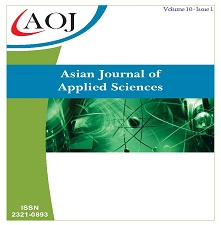Subsurface Evapotranspiration Irrigation System Design in System of Rice Intensification (SRI) Salibu Paddy Cultivation
DOI:
https://doi.org/10.24203/ajas.v10i1.6891Keywords:
Evapotranspiration irrigation system, SRI Salibu, Rice CultivationAbstract
The System of Rice Intensification (SRI), a water-saving paddy cultivation system, has been implemented in Indonesia. The application of SRI can increase water productivity. The Salibu method applied to paddy cultivation can save seeds, costs, labour and increase the planting index of paddy. However, when used in other areas, the yield is reduced by up to 50 per cent from the first harvest. A combination of cultivation and water management is needed to save water and increase paddy production. The method used in this research is experimental research. The design of the irrigation system was made according to the technical design, then tested for automatic water management. The design was tested with the SRI Salibu method. The data are climate data, water level, water discharge, and water content. The climate data used are temperature and solar radiation to determine potential evapotranspiration. The results of observations of water depth, the volume of water in the system, the water content in the media, water entering the system (rain infiltration, irrigation discharge), and water leaving the system (runoff, discharge) are entered into the water balance equation (water balance). The plant coefficient value is included in the water balance equation as a plant coefficient factor multiplied by the potential evapotranspiration value. Then the plant coefficient value for each observation is optimized by reducing the error value to get the coefficient value for SRI Salibu. The results showed that the appropriate evapotranspiration irrigation system for SRI Salibu paddy cultivation is the fifth irrigation system design. The fifth irrigation system design can produce 4.7 tons/ha of paddy (SRI method) and produce SRI Salibu paddy yields of 8 tons/ha. The irrigation water for SRI paddy cultivation is 1738 litres, and the water production is 1.2 kg/m3.
References
Abdulrachman S, Suhartatik E, Erdiman, Susilawati, Zaini Z, Jamil A, Mejaya MJ, Sasmita P, Abdullah B, Suwarno B, et al. 2015. Panduan Teknologi Budidaya Padi Salibu
Anas I, Uphoff N. 2009. Prospect of The System of Rice Intensification ( SRI ) in Asia. http://d.yimg.com/kq/groups/21477406/398766272/name/Iswandi+and+Uphoff+abstract+PROSPECT+OF+SYSTE M+OF+RICE+INTENSIFICATION.doc.
Arif C, Setiawan BI, Sofiyuddin HA, Martief LM, Mizoguchi M, Doi R. 2012. Estimating Crop Coefficient in Intermittent Irrigation Paddy Fields Using Excel Solver. Rice Sci. 19(2):143–152. doi:10.1016/S1672-6308(12)60033-X
Bouman, B.A.M. and Tuong, T.P. 2001 Field Water Management to Save Water and Increase its Productivity in Irrigated Lowland Rice. Agricultural Water Management, 49, 11-30.
Fitri R, Erdiman, Kusnadi N, Yamaoka K. 2019. SALIBU technology in Indonesia: an alternative for efficient use of agricultural resources to achieve sustainable food security. Paddy Water Environ. 17(3):403–410. doi:10.1007/s10333-019-00735-0.
Fuadi, N. A., Purwanto, M. Y. J., & Tarigan, S. D. (2016). Kajian kebutuhan air dan produktivitas air padi sawah dengan sistem pemberian air secara sri dan konvensional menggunakan irigasi pipa. Jurnal Irigasi, 11(1), 23-32.
Hasanah NAI, Setiawan BI, Arif C, Widodo S. 2015. Evaluasi Koefisien Tanaman Padi Pada Berbagai Perlakuan Muka Air. J Irig. 10(2):57. doi:10.31028/ji.v10.i2.57-68.
Nurrochmad, F. 2007. Analisis kinerja jaringan irigasi. agriTECH, 27(4).
Pasaribu PO, Triadiati, Anas I. 2018. Rice ratooning using the salibu system and the system of rice intensification method influenced by physiological traits. Pertanika J Trop Agric Sci. 41(2):637–654.
Subagio H. 2019. Evaluasi Penerapan Teknologi Intensifikasi Budidaya Padi di Lahan Rawa Pasang Surut. J Pangan. 28(2):95–108. doi:10.33964/jp.v28i2.438.
Subagyono K, Dariah A, Surmaini E, Kurnia U. 2004. Pengelolaan air pada tanah sawah. Tanah Sawah dan Teknol Pengelolaannya., siap terbit.
Subari S, Joubert MD, Sofiyuddin HA, Triyono J. 2012. Pengaruh Perlakuan Pemberian Air Irigasi pada Budidaya SRI, PTT dan Konvensional terhadap Produktivitas Air. J Irig. 7(1):28. doi:10.31028/ji.v7.i1.28-42.
Uphoff N, Fasoula V, Iswandi A, Kassam A, Thakur AK. 2015. Improving the phenotypic expression of rice genotypes: Rethinking “intensification” for production systems and selection practices for rice breeding. Crop J. 3(3):174–189. doi:10.1016/j.cj.2015.04.001.
Wardana P, Widyantoro, Rahmini, Abdulrachman S, Zaini Z, Jamil A, Mejaya MJ, Sasmita P, Suwarno, Suhartatik E, et al. 2015. Panduan Teknologi Budidaya Padi SRI (System of Rice Intensification.
Downloads
Published
How to Cite
Issue
Section
License
Copyright (c) 2022 Hilda Agustina, Budi Indra Setiawan, Sugiyanta, Mohamad Solahudin, Vita Ayu Kusuma Dewi

This work is licensed under a Creative Commons Attribution-NonCommercial 4.0 International License.
- Papers must be submitted on the understanding that they have not been published elsewhere (except in the form of an abstract or as part of a published lecture, review, or thesis) and are not currently under consideration by another journal published by any other publisher.
- It is also the authors responsibility to ensure that the articles emanating from a particular source are submitted with the necessary approval.
- The authors warrant that the paper is original and that he/she is the author of the paper, except for material that is clearly identified as to its original source, with permission notices from the copyright owners where required.
- The authors ensure that all the references carefully and they are accurate in the text as well as in the list of references (and vice versa).
- Authors retain copyright and grant the journal right of first publication with the work simultaneously licensed under a Attribution-NonCommercial 4.0 International that allows others to share the work with an acknowledgement of the work's authorship and initial publication in this journal.
- Authors are able to enter into separate, additional contractual arrangements for the non-exclusive distribution of the journal's published version of the work (e.g., post it to an institutional repository or publish it in a book), with an acknowledgement of its initial publication in this journal.
- Authors are permitted and encouraged to post their work online (e.g., in institutional repositories or on their website) prior to and during the submission process, as it can lead to productive exchanges, as well as earlier and greater citation of published work (See The Effect of Open Access).
- The journal/publisher is not responsible for subsequent uses of the work. It is the author's responsibility to bring an infringement action if so desired by the author.

